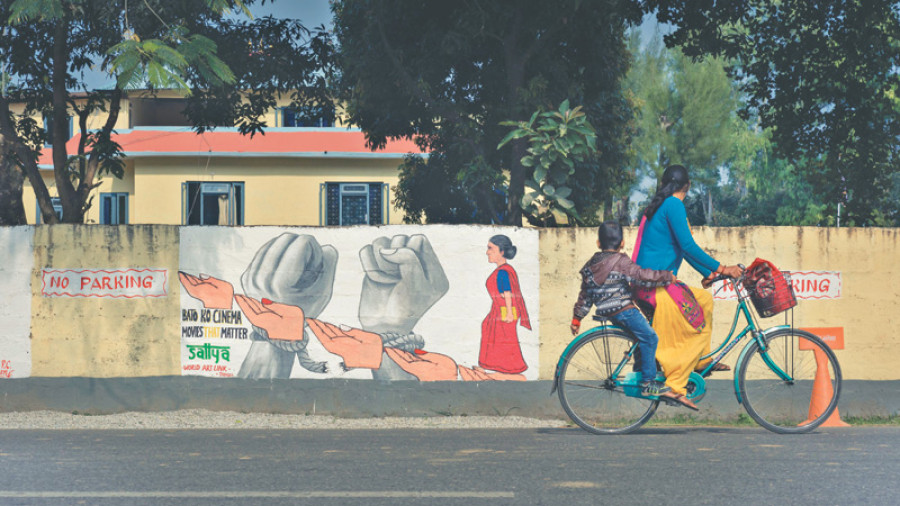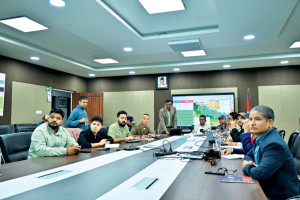Miscellaneous
Interrupted
If someone tells you gender inequality does not exist in this day and age, where scientists think there might be a possibility of colonising Mars, tell them to Google the news story of Thegani Devi Mahato—a 40-year-old widow and a mother of two children, a boy of 12 years and a girl of nine—who was dragged by men from her home, beaten, then burned alive for being accused of witchcraft by the locals of Madi, Chitwan.
Sujan G Amatya
If someone tells you gender inequality does not exist in this day and age, where scientists think there might be a possibility of colonising Mars, tell them to Google the news story of Thegani Devi Mahato—a 40-year-old widow and a mother of two children, a boy of 12 years and a girl of nine—who was dragged by men from her home, beaten, then burned alive for being accused of witchcraft by the locals of Madi, Chitwan.
Tell them to Google violence against women, and prepare themselves for the onslaught of pages and pages of search results, and article upon article of horrific acts of injustice against women in Nepal. Let these stories permeate through your sense of humanity.
“We may think these kinds of horrific acts were wicked ways of the past, but even today, they still haunt women in Nepal,” says Bobby Thapa, from Sattya Media Arts Collective. Girls are still considered paraya dhan (other’s property), receive little or no formal education, have limited decision-making power in the household, and top it all off, these acts are justified in the name of tradition and religion.
“This is not okay,” says Sazeena Nemkul, managing director at Sattya, “we needed to break this trance that everything is all right,” and they found way to break the spell through one medium—films.
With the hope of transforming lives through films, Sattya embarked on this year’s Bato Ko Cinema (BKC), which turned Nepal’s public spaces into an open-air street cinema, on September 26, in Pokhara. The project, which came to an end on December 3 in Pokhara, screened social films and documentaries with stories that ranged from girls’ education to disability to human trafficking to child marriage. The public screening of the movies became a convenient and an easily accessible doorway to educate, reflect, criticise and debate.
Sattya started the project with the funding from Movies That Matter (Netherlands), and it was decided that the team would conduct 26 screenings in Bhaktapur, Banepa, Sankhu, Panauti, Birgunj, Bharatpur and Pokhara. The screenings were free of cost, and some of the movies were even dubbed from Telegu and Mandarin to Nepali, as the organisers felt that the messages in these films need to be heard loud and clear.
The art of filmmaking has generated a new level of excitement in Kathmandu over the years, with various film festivals and screenings popping up every month; and why wouldn’t it? This medium has the ability to easily engage the masses and has become an unstoppable catalyst for personal and social change. This form of therapy can accomplish what the spoken and written language can sometimes struggle to.
Film has always been a powerful agent of change against social indifference, with an unprecedented capacity to open eyes, and to work as a mouthpiece for victims of injustice. You may have forgotten the plotlines of a movie, but you still remember what it made you feel. This is where Sound of One Leg Dancing inspired viewers at BKC, where a girl who lost one of her legs at a young age in a domestic accident, challenged her obstacles to enter a dance competition, despite poverty and disability. This is where Days Out came in, where women are prohibited from participating in normal family activities during their menstruation, as they are considered “impure”, and resigned to cattle sheds or a makeshift hut.
Before the screening, BKC also introduced the films and why they are being shown, and a community was encouraged to raise questions and share stories post-screening. Powerful stories and notes were collected. BKC even painted a mural to serve as a visual and vivid reminder of continued fight for justice. BKC has interrupted the lives of not just the women by injecting into their schedules stories of change, but also affected the psyche of the community, on a sensorial level through an intermingling of the visual arts—music, photography, cinematography, lighting and literature.
In the same locale where Mahato was burnt, BKC came across a father whose daughter was viciously beaten and burned. He later revealed that his daughter was burnt alive in the very spot they held the meeting, but contemplated that, for him, the screening served as a homage to her, and wished that no family would have to go through what he did.
After the screening, he hoped for no more lives of innocent women were interrupted but, more importantly, the culprits wouldn’t walk away scot-free, or worse, be ignored.




 21.12°C Kathmandu
21.12°C Kathmandu










